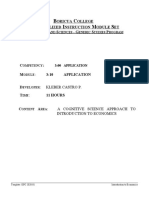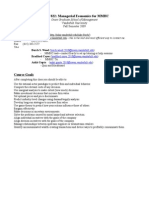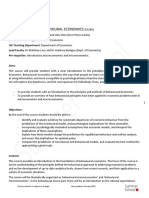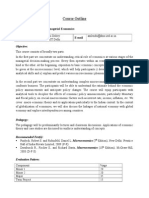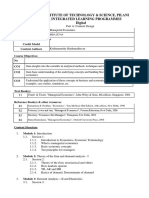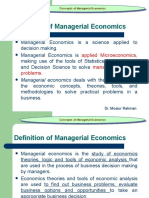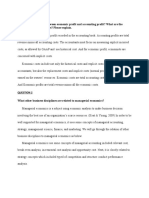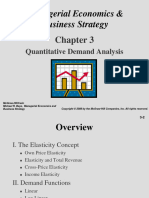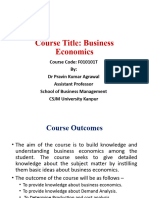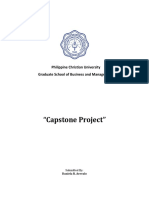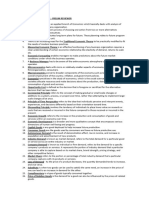SUBJECT: Managerial Competencies: Managerial Economics
PROFESSOR: Langer
PROGRAM AREA: Managerial Competencies
INTAKE: All
TOTAL LESSON HOURS: 7.5/10.0 (timing depends on master’s program)
LANGUAGE: English
COURSE FORMATIVE OBJECTIVES:
In this course students learn basic economic principles. Topics covered include 1) macroeconomic
principles: national income accounting, trade, balance of payments (and trade deficits),
government fiscal and monetary policies, economic crises; 2) microeconomics: markets, prices,
wages, competition; 3) behavioral economics: choice, irrationality, influencing factors.
INTENDED LEARNING OUTCOMES – ILO’S:
• Develop accurate assessments of foreign and domestic economic environments including
applying the right economic tools for business decision-making
• Apply analytical skills to craft analyses that illuminate macroeconomic realities affecting
domestica and international monetary relations.
• Apply microeconomic policies related to wages, prices and market principles.
• Understand principles of trade theory.
• Distinguish between the different market structures and pricing practices available to and
used by firms.
COURSE CONTENTS
EXTENDED PROGRAM AND REFERENCE READING MATERIAL: LESSON 1, DATE: 11/23/20 TIME: 0930
Topic: Macroeconomic principles: national income accounting, trade, balance of payments (and
trade deficits), government fiscal and monetary policies, economic crises.
Short overview of the lesson: Prestation of macroeconomic principles, videos on economic
events, review of notes and reading.
Pre reading if any: Samuelson, Nordhaus, Economics, 19th Ed., McGraw-Hill, 2010, Chapters
19-22 (labeled PC19 in notes) (provided by instructor)
Case study: Weight Watchers Mexico Exhibit 7
In class activity 1 (Type and Purpose): Q&A related to macroeconomic principles, students
present answers.
Required materials and materials for home readings: Samuelson, Nordhaus, Economics,
19th Ed., McGraw-Hill, 2010, Chapters 19-22 (labeled PC19 in notes) (provided by
instructor), instructors class notes, YouTube videos in notes
1
�EXTENDED PROGRAM AND REFERENCE READING MATERIAL: LESSON 2, DATE: 11/24/20 TIME: 0930
Topic: Microeconomics: prices, wages, competition.
Short overview of the lesson: Microeconomic principles: Prices, wages, competition, review
of reading, notes.
Pre reading if any: Mankiw, Principles of Economics, 7th Ed., Cengage, 2015, Chapters 8-11
(labeled PE7 in notes) (provided by instructor)
Case study: Jamaica IMF (video case study)
In class activity 1 (Type and Purpose): Q&A on microeconomic concepts, answers
presented by students.
Required materials and materials for home readings: Mankiw, Principles of Economics, 7th
Ed., Cengage, 2015, Chapters 8-11 (labeled PE7 in notes) (provided by instructor),
instructors class notes, YouTube videos in notes
EXTENDED PROGRAM AND REFERENCE READING MATERIAL: LESSON 3, DATE: 11/25/20 TIME: 0930
Topic: Behavioral economics: Irrational consumer decisions, influencing factors, application to
human resource management and to marketing.
Short overview of the lesson: Behavioral economic principles: Discuss business and
consumer decision making and choice, present influencing factors to consider, introduce
applications such as hiring/firing/promotion/work distribution, consumer response, trends,
fads, review of reading, notes.
Pre reading if any:
• https://www.psychologytoday.com/us/blog/science-choice/201705/what-is-
behavioral-economics (article also posted in Dropbox link)
• https://www2.deloitte.com/us/en/insights/deloitte-review/issue-18/behavioral-economics-evidence-
based-hr-management.html (article also posted in Dropbox link)
• https://www.psychologytoday.com/us/basics/behavioral-economics
Case study (video): Google on benefits/services: https://www.youtube.com/watch?v=9ANgEo40VSE
In class activity 1 (Type and Purpose): Discussion of select videos on application of
behavioral economic concepts.
Required materials and materials for home readings: websites listed above, instructors
class notes, YouTube videos in notes
EXTENDED PROGRAM AND REFERENCE READING MATERIAL: LESSON 4, DATE: 11/26/20 TIME: 0930
Topic: Macroeconomics, microeconomics and behavioral economics application in real life
business situations: application to human resource management, marketing and fashion using
select video scenarios.
Short overview of the lesson: Present video scenario(s), discuss, increase utilization, reach,
efficiency, by demonstrating applicability of macroeconomic, microeconomic and behavior
economic concepts, review of reading, notes.
Pre reading/watching if any:
• Coronavirus: A visual guide to the economic impact: https://www.bbc.com/news/business-51706225
• 6 charts show the coronavirus impact on the global economy and markets so far:
https://www.cnbc.com/2020/03/12/coronavirus-impact- on-global-economy-
financial-markets-in-6-charts.html
• Psychology of asking for a raise (Barbara Corcoran): https://www.youtube.com/watch?v=FWxoI0RrPvc
• Delivering negative feedback: https://www.youtube.com/watch?v=s76bX5ujl_4
• Employee discipline: https://www.youtube.com/watch?v=qv2nxVXXD8I
• Nudge theory: https://www.youtube.com/watch?v=jVTg3ZsNTTY
• Behavioral economics in marketing: https://www.youtube.com/watch?v=-4dCGp3MrMI
• True cost of fast fashion: https://www.youtube.com/watch?v=tLfNUD0-8ts
Case study (video): Google on benefits/services: https://www.youtube.com/watch?v=9ANgEo40VSE
In class activity 1 (Type and Purpose): Discussion of select videos on application of
economic concepts.
Required materials and materials for home readings: websites listed above, instructors
class notes, YouTube videos in notes
2
�REFERENCE MATERIALS:
See readings in Dropbox:
https://www.dropbox.com/sh/3x18d1tpi90mn15/AABgMP_KcZ2OvPL4EcY1AUeqa?dl=0
Samuelson, Nordhaus, Economics, 19th Ed., McGraw-Hill, 2010 (labeled PC19 in notes)
Mankiw, Principles of Economics, 7th Ed., Cengage, 2015 (labeled PE7 in notes)
Hill, Napoleon, Think and Grow Rich: Your Key to Financial Wealth and Power, Success Co., 2010
Voss, Never Split the Difference, Harper, 2016
Coronavirus: A visual guide to the economic impact: https://www.bbc.com/news/business-51706225
6 charts show the coronavirus impact on the global economy and markets so far:
https://www.cnbc.com/2020/03/12/coronavirus-impact- on-global-economy-financial-markets-in-6-charts.html
https://www.psychologytoday.com/us/blog/science-choice/201705/what-is-behavioral-
economics (article also posted in Dropbox link)
https://www2.deloitte.com/us/en/insights/deloitte-review/issue-18/behavioral-economics-evidence-based-hr-
management.html (article also posted in Dropbox link)
https://www.psychologytoday.com/us/basics/behavioral-economics
TEACHING METHOD:
Didactic – 40%
- traditional frontal lecture 30%
- cases studies 10%
Learn by doing – 60%
- learning by doing – including lecture Q&A - 35%
- individual exercises 10%
- team work 10%
- presentations, assignments, practice Q&A 5%
ASSESSMENT METHOD:
Class participation, activity volunteer: 30%
End of module test: 70%
CLASSROOM ETIQUETTE:
• Punctuality
• No use of laptops in class if not required
• No use of mobile phones in class
• No eating in class
CONTACT DETAILS:
Professor email contact: mlanger11@gmail.com / +39 347.1763096












